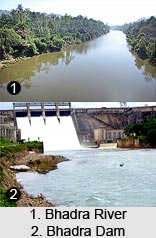 Bhadra River is a river of the Western Ghats in India. The river flows in Karnataka state of southern India. It begins at the Western Ghats range, and flows east across the Deccan Plateau. Finally, the tributaries at the Somavahini, Thadabehalla and Odirayanahalla join it. The river flows across the Bhadra Wildlife Sanctuary. The Bhadra meets the Tunga River at Koodli, a small town near Shivamogga. The combined river continues east as the Tungabhadra, a major tributary of the Krishna, which drains into the Bay of Bengal.
Bhadra River is a river of the Western Ghats in India. The river flows in Karnataka state of southern India. It begins at the Western Ghats range, and flows east across the Deccan Plateau. Finally, the tributaries at the Somavahini, Thadabehalla and Odirayanahalla join it. The river flows across the Bhadra Wildlife Sanctuary. The Bhadra meets the Tunga River at Koodli, a small town near Shivamogga. The combined river continues east as the Tungabhadra, a major tributary of the Krishna, which drains into the Bay of Bengal.
Bhadra Dam on Bhadra River
The Bhadra Dam was built on this river near Lakkavalli. It was built to a height of 59.13 meters between 1947and 1965 with the aim of increasing agricultural prosperity, particularly for rice production. Apart from agriculture, it also aims to increase irrigation and power production. It has a gross storage capacity of 2.025 km3, live storage of 63.00 BCF at full reservoir level and a dead storage of 8.50 BCF at reservoir level of 631.54 meters.
Water Sports in Bhadra River
Water sports like river rafting is quite popular in Bhadra River. The river rafting location is situated 280 kms from Bangalore, 70 kms from Chikmagalur and 50 kms from Kudremukh. This location is considered ideal by many adventure enthusiasts as its bank is surrounded by villages, forests and plantations. While rafting, people will pass through some thick jungles.
This place is also considered as ideal for a weekend or short adventure trip for the presence of some of the best hills and wildlife areas in the Western Ghats like Sakleshpur, Kudremukh, Chikmagalur and Charmadi Ghats.
This article is a stub. You can enrich by adding more information to it. Send your Write Up to content@indianetzone.com















